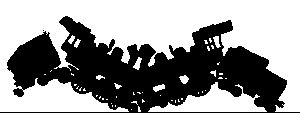
Canton Massachusetts Historical Society

This Article was originally published in the 8/12/1898 Canton Journal Newspaper
![]() DEATH ON THE RAIL
DEATH ON THE RAIL
![]()
The Postal Train Wreck
Great Excitement Monday Morning
Three Men Instantly Killed
Thousands Visit The Scene
People in the neighborhood of the Junction were just preparing to take up their week’s round of labor, when about ten minutes after five a terrible roar followed by a fearful crash directed attention toward the Junction depot, whence arose a mingled cloud of dust and steam.
The nearest the scene quickly realized that a terrible accident had occurred and as the quickest means of obtaining aid, box 93 of the fire alarm was pulled and in a very few minutes the firemen were hurrying to the scene. Fortunately their services were not required, but the call was unanimously endorsed and the prompt response appreciated.
The derailed train is known on the road as the Postal Express and was made up of four postal cars. It left New York at about 11 o’clock Sunday night and was about on its regular time. At New London engine 839 (engineer Frank Sheldon, of Providence, fireman F. P. Knowlton, of Chelsea) was attached to the train and at Mansfield James Schufeldt, of that place, got upon the engine to ride into the city to take charge of his engine on the gravel train.
The morning was clear and when crossing the Viaduct engineer Sheldon could easily discern the signals, which indicated a clear track. Apparently there was no warning to the doomed men. As a rule with a clear track express trains slide over the bridge at fifteen to twenty miles an hour and on reaching the straight track the throttle is opened and by the time the depot was reached the speed is practically doubled. This appears to have been the case this morning.. It seems doubtful if steam was shut off before the switch was reached. Those in the cars felt no application of brakes and the few lookers-on were too horrified by the sudden catastrophe to be able to recollect just what was the condition at the moment the engine left the rails.
The signals were all set for a straight track, but it was evident from the examination of the rails that the cross-over switch just north of the tower was nearly or quite set to cross on to the outward track. Some who looked at it shortly after the accident say it was set clear over, others claim that there was a slight gap between the rails, showing that it had been partly moved. A pin, or rather double-headed rivet in one of the rods that should have moved the switch had cracked and dropped out, allowing the rod to pull out of the connection. The crack was said to be somewhat rusted and probably to have commenced to yield some time back, but it was in a place where detection would have been difficult if not impossible without taking the connection apart.
However, the rails turned the locomotive from the straight track and the momentum being too great to allow the heavy machine to be so abruptly turned from its course, it plunged diagonally across the switch and dived like an immense plow into the space between the tracks. The road bed was excavated to the depth of a yard for some fifty feet, the planking in front of the baggage-room carried away, and leaving the forward truck in front of the depot, the machine fell on its side and with well nigh everything stripped from boiler and frame, lay blowing off steam just north of the depot on the outbound track. The first car of the train followed the engine till its fall, when it also turned on its side, falling over on the turn-out west of the outbound track and slid by the tender cutting off the top of the cab and catching one of the unfortunate men on the engine under its forward end, crushed him into the ground beneath it. The other two men were found beneath the ruined cab. In this car were five mail clerks, who were thrown around, to use the expression of one of them, "like dice in a box." All were more or less injured and their wounds being temporarily dressed, were taken to Boston on a train at 6:30 to the hospital, where they were attended to and with the exception of Buckland sent home. The latter remained at the hospital, but is not thought to be dangerously hurt. The trucks of all the cars, the gas tanks, brake cylinders and all the rigging underneath the cars stuck in the trench dug by the locomotive in front of the baggage door and only the forward locomotive truck passed that spot. The second car laid right side up diagonally across the three tracks, while the third formed almost a right angle with it, the front end lifted high on the wrecked trucks lacking only a few inches of driving into the shelter roof of the station. The fourth car alone remained on its trucks, but the forward one was broken to such an extent as to require heavy chains to hold it together and was terribly strained. The track and interlocking signals were torn up and scattered in every direction.
The work of rescuing the imprisoned mail clerks was commenced without delay and by the time the firemen reached the scene all were in safety except the three engine-men who were too plainly beyond help.
The wrecking train arrived about six o’clock with the steam derrick and after taking out the bodies (which were viewed by Medical Examiner Faxon, of Stoughton, and then taken in charge by Undertaker Spencer) the work of clearing up the wreck was commenced. A large force of men was brought out by the seven o’clock train to help with the track laying.
Trains were switched around the wreck through the freight yard, causing but slight delay on the main line, but Branch passengers were obliged to change cars and walk around the wreck all day. Supt. McAlpine and many other high officials spent the day on the spot.
An immense crowd gathered, coming from a considerable distance, to view the ruins and the camera was much in evidence. The work seemed to progress rather slowly through the day, but by early morning Tuesday the tracks were cleared and shortly after eight the wrecking train returned to the city leaving the interlocking men to restore the switch and signal system.
It was the most complete wreck that ever occurred at the Junction and it is only owing to the character of the train that the loss of life was so small. It was also a great testimony to the advantages of the vestibule platform, as it is evident that with ordinary platforms the cars would have ground each other into splinters. The work of the steam derrick excited much commendation and the railroad hands generally are entitled to much credit for the manner in which they worked under the broiling sun, hampered to a considerable extent by the crowd and bothered with inquisitive questioners, yet with rare exceptions courteous and good natured. From superintendent to the water boy they treated the visitors (unwelcome as they must have been) with very few exceptions as though they were giving an exhibition rather than engaged in a harassing and exhausting work. It is also a consolation to know that in all human probability this was one of the few wrecks that can really be called an accident and not due to man’s negligence or incapacity.
![]() CLICK
HERE To See Pictures Of The
Wreck
CLICK
HERE To See Pictures Of The
Wreck ![]()

This Page Was Created
With
Microsoft FrontPage 98